Yifan Gong
Fred
LazyDiT: Lazy Learning for the Acceleration of Diffusion Transformers
Dec 17, 2024Abstract:Diffusion Transformers have emerged as the preeminent models for a wide array of generative tasks, demonstrating superior performance and efficacy across various applications. The promising results come at the cost of slow inference, as each denoising step requires running the whole transformer model with a large amount of parameters. In this paper, we show that performing the full computation of the model at each diffusion step is unnecessary, as some computations can be skipped by lazily reusing the results of previous steps. Furthermore, we show that the lower bound of similarity between outputs at consecutive steps is notably high, and this similarity can be linearly approximated using the inputs. To verify our demonstrations, we propose the \textbf{LazyDiT}, a lazy learning framework that efficiently leverages cached results from earlier steps to skip redundant computations. Specifically, we incorporate lazy learning layers into the model, effectively trained to maximize laziness, enabling dynamic skipping of redundant computations. Experimental results show that LazyDiT outperforms the DDIM sampler across multiple diffusion transformer models at various resolutions. Furthermore, we implement our method on mobile devices, achieving better performance than DDIM with similar latency.
Fast and Memory-Efficient Video Diffusion Using Streamlined Inference
Nov 02, 2024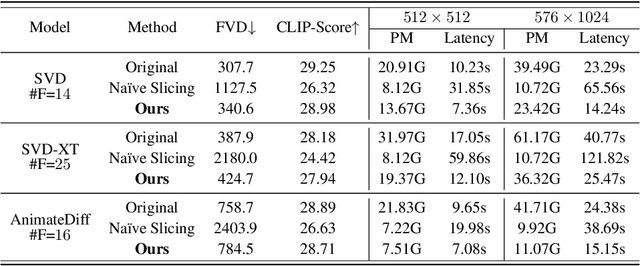
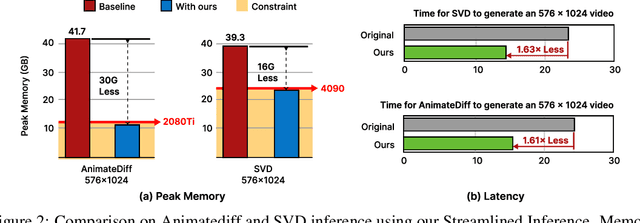

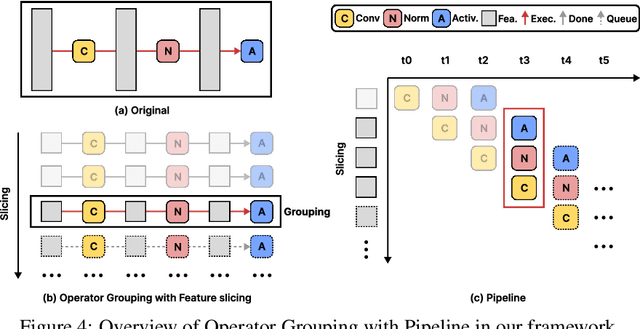
Abstract:The rapid progress in artificial intelligence-generated content (AIGC), especially with diffusion models, has significantly advanced development of high-quality video generation. However, current video diffusion models exhibit demanding computational requirements and high peak memory usage, especially for generating longer and higher-resolution videos. These limitations greatly hinder the practical application of video diffusion models on standard hardware platforms. To tackle this issue, we present a novel, training-free framework named Streamlined Inference, which leverages the temporal and spatial properties of video diffusion models. Our approach integrates three core components: Feature Slicer, Operator Grouping, and Step Rehash. Specifically, Feature Slicer effectively partitions input features into sub-features and Operator Grouping processes each sub-feature with a group of consecutive operators, resulting in significant memory reduction without sacrificing the quality or speed. Step Rehash further exploits the similarity between adjacent steps in diffusion, and accelerates inference through skipping unnecessary steps. Extensive experiments demonstrate that our approach significantly reduces peak memory and computational overhead, making it feasible to generate high-quality videos on a single consumer GPU (e.g., reducing peak memory of AnimateDiff from 42GB to 11GB, featuring faster inference on 2080Ti).
Rethinking Token Reduction for State Space Models
Oct 16, 2024



Abstract:Recent advancements in State Space Models (SSMs) have attracted significant interest, particularly in models optimized for parallel training and handling long-range dependencies. Architectures like Mamba have scaled to billions of parameters with selective SSM. To facilitate broader applications using Mamba, exploring its efficiency is crucial. While token reduction techniques offer a straightforward post-training strategy, we find that applying existing methods directly to SSMs leads to substantial performance drops. Through insightful analysis, we identify the reasons for this failure and the limitations of current techniques. In response, we propose a tailored, unified post-training token reduction method for SSMs. Our approach integrates token importance and similarity, thus taking advantage of both pruning and merging, to devise a fine-grained intra-layer token reduction strategy. Extensive experiments show that our method improves the average accuracy by 5.7% to 13.1% on six benchmarks with Mamba-2 compared to existing methods, while significantly reducing computational demands and memory requirements.
Exploring Token Pruning in Vision State Space Models
Sep 27, 2024



Abstract:State Space Models (SSMs) have the advantage of keeping linear computational complexity compared to attention modules in transformers, and have been applied to vision tasks as a new type of powerful vision foundation model. Inspired by the observations that the final prediction in vision transformers (ViTs) is only based on a subset of most informative tokens, we take the novel step of enhancing the efficiency of SSM-based vision models through token-based pruning. However, direct applications of existing token pruning techniques designed for ViTs fail to deliver good performance, even with extensive fine-tuning. To address this issue, we revisit the unique computational characteristics of SSMs and discover that naive application disrupts the sequential token positions. This insight motivates us to design a novel and general token pruning method specifically for SSM-based vision models. We first introduce a pruning-aware hidden state alignment method to stabilize the neighborhood of remaining tokens for performance enhancement. Besides, based on our detailed analysis, we propose a token importance evaluation method adapted for SSM models, to guide the token pruning. With efficient implementation and practical acceleration methods, our method brings actual speedup. Extensive experiments demonstrate that our approach can achieve significant computation reduction with minimal impact on performance across different tasks. Notably, we achieve 81.7\% accuracy on ImageNet with a 41.6\% reduction in the FLOPs for pruned PlainMamba-L3. Furthermore, our work provides deeper insights into understanding the behavior of SSM-based vision models for future research.
Search for Efficient Large Language Models
Sep 25, 2024


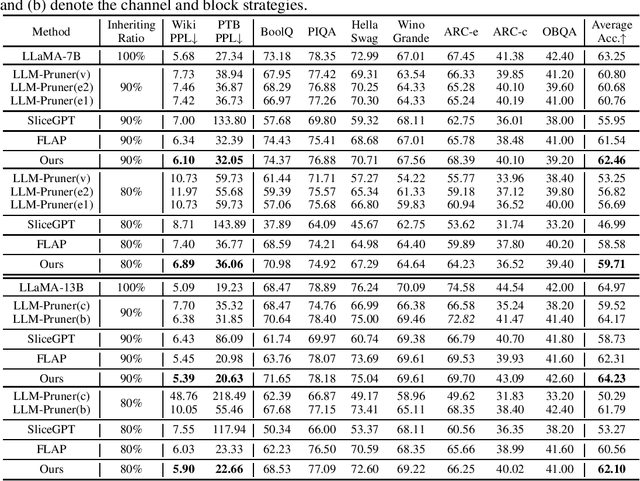
Abstract:Large Language Models (LLMs) have long held sway in the realms of artificial intelligence research. Numerous efficient techniques, including weight pruning, quantization, and distillation, have been embraced to compress LLMs, targeting memory reduction and inference acceleration, which underscore the redundancy in LLMs. However, most model compression techniques concentrate on weight optimization, overlooking the exploration of optimal architectures. Besides, traditional architecture search methods, limited by the elevated complexity with extensive parameters, struggle to demonstrate their effectiveness on LLMs. In this paper, we propose a training-free architecture search framework to identify optimal subnets that preserve the fundamental strengths of the original LLMs while achieving inference acceleration. Furthermore, after generating subnets that inherit specific weights from the original LLMs, we introduce a reformation algorithm that utilizes the omitted weights to rectify the inherited weights with a small amount of calibration data. Compared with SOTA training-free structured pruning works that can generate smaller networks, our method demonstrates superior performance across standard benchmarks. Furthermore, our generated subnets can directly reduce the usage of GPU memory and achieve inference acceleration.
Efficient Training with Denoised Neural Weights
Jul 16, 2024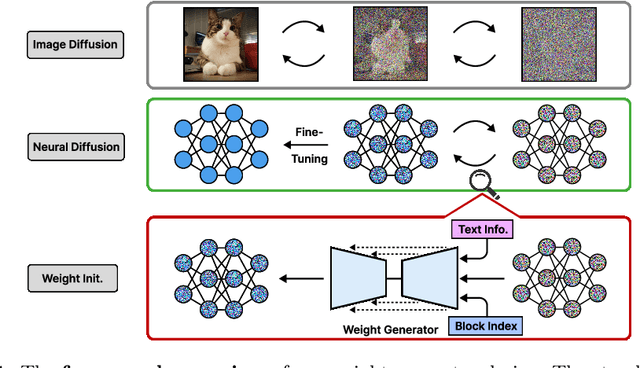
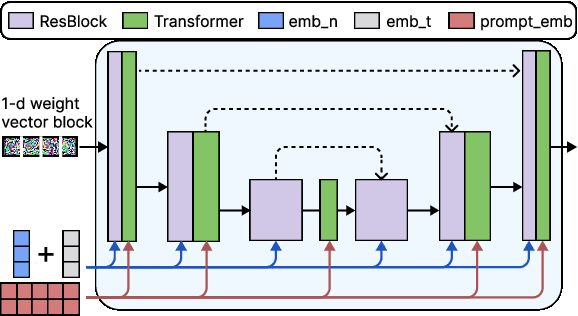
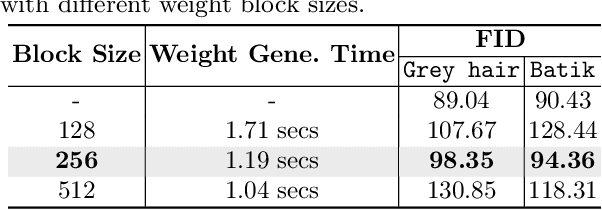
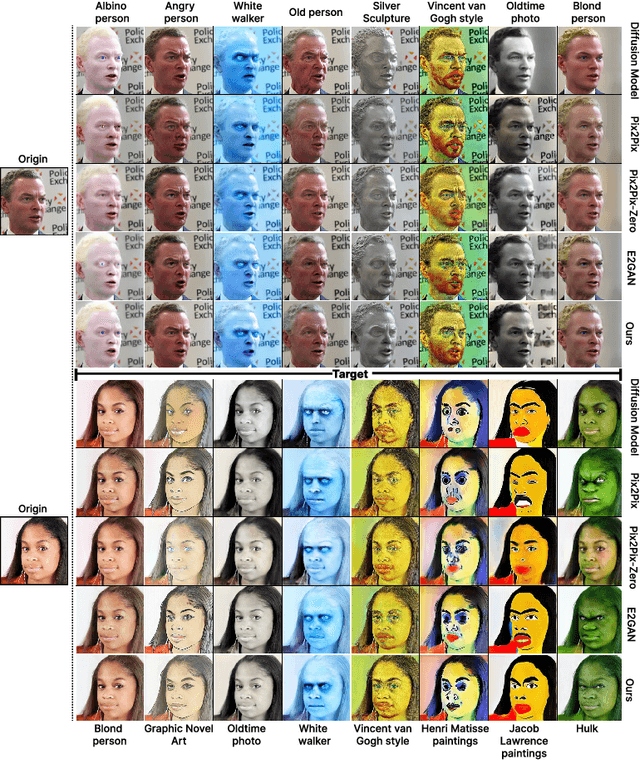
Abstract:Good weight initialization serves as an effective measure to reduce the training cost of a deep neural network (DNN) model. The choice of how to initialize parameters is challenging and may require manual tuning, which can be time-consuming and prone to human error. To overcome such limitations, this work takes a novel step towards building a weight generator to synthesize the neural weights for initialization. We use the image-to-image translation task with generative adversarial networks (GANs) as an example due to the ease of collecting model weights spanning a wide range. Specifically, we first collect a dataset with various image editing concepts and their corresponding trained weights, which are later used for the training of the weight generator. To address the different characteristics among layers and the substantial number of weights to be predicted, we divide the weights into equal-sized blocks and assign each block an index. Subsequently, a diffusion model is trained with such a dataset using both text conditions of the concept and the block indexes. By initializing the image translation model with the denoised weights predicted by our diffusion model, the training requires only 43.3 seconds. Compared to training from scratch (i.e., Pix2pix), we achieve a 15x training time acceleration for a new concept while obtaining even better image generation quality.
NOTSOFAR-1 Challenge: New Datasets, Baseline, and Tasks for Distant Meeting Transcription
Jan 16, 2024

Abstract:We introduce the first Natural Office Talkers in Settings of Far-field Audio Recordings (``NOTSOFAR-1'') Challenge alongside datasets and baseline system. The challenge focuses on distant speaker diarization and automatic speech recognition (DASR) in far-field meeting scenarios, with single-channel and known-geometry multi-channel tracks, and serves as a launch platform for two new datasets: First, a benchmarking dataset of 315 meetings, averaging 6 minutes each, capturing a broad spectrum of real-world acoustic conditions and conversational dynamics. It is recorded across 30 conference rooms, featuring 4-8 attendees and a total of 35 unique speakers. Second, a 1000-hour simulated training dataset, synthesized with enhanced authenticity for real-world generalization, incorporating 15,000 real acoustic transfer functions. The tasks focus on single-device DASR, where multi-channel devices always share the same known geometry. This is aligned with common setups in actual conference rooms, and avoids technical complexities associated with multi-device tasks. It also allows for the development of geometry-specific solutions. The NOTSOFAR-1 Challenge aims to advance research in the field of distant conversational speech recognition, providing key resources to unlock the potential of data-driven methods, which we believe are currently constrained by the absence of comprehensive high-quality training and benchmarking datasets.
E$^{2}$GAN: Efficient Training of Efficient GANs for Image-to-Image Translation
Jan 11, 2024



Abstract:One highly promising direction for enabling flexible real-time on-device image editing is utilizing data distillation by leveraging large-scale text-to-image diffusion models, such as Stable Diffusion, to generate paired datasets used for training generative adversarial networks (GANs). This approach notably alleviates the stringent requirements typically imposed by high-end commercial GPUs for performing image editing with diffusion models. However, unlike text-to-image diffusion models, each distilled GAN is specialized for a specific image editing task, necessitating costly training efforts to obtain models for various concepts. In this work, we introduce and address a novel research direction: can the process of distilling GANs from diffusion models be made significantly more efficient? To achieve this goal, we propose a series of innovative techniques. First, we construct a base GAN model with generalized features, adaptable to different concepts through fine-tuning, eliminating the need for training from scratch. Second, we identify crucial layers within the base GAN model and employ Low-Rank Adaptation (LoRA) with a simple yet effective rank search process, rather than fine-tuning the entire base model. Third, we investigate the minimal amount of data necessary for fine-tuning, further reducing the overall training time. Extensive experiments show that we can efficiently empower GANs with the ability to perform real-time high-quality image editing on mobile devices with remarkable reduced training cost and storage for each concept.
Value FULCRA: Mapping Large Language Models to the Multidimensional Spectrum of Basic Human Values
Nov 15, 2023Abstract:The rapid advancement of Large Language Models (LLMs) has attracted much attention to value alignment for their responsible development. However, how to define values in this context remains a largely unexplored question. Existing work mainly follows the Helpful, Honest, Harmless principle and specifies values as risk criteria formulated in the AI community, e.g., fairness and privacy protection, suffering from poor clarity, adaptability and transparency. Inspired by basic values in humanity and social science across cultures, this work proposes a novel basic value alignment paradigm and introduces a value space spanned by basic value dimensions. All LLMs' behaviors can be mapped into the space by identifying the underlying values, possessing the potential to address the three challenges. To foster future research, we apply the representative Schwartz's Theory of Basic Values as an initialized example and construct FULCRA, a dataset consisting of 5k (LLM output, value vector) pairs. Our extensive analysis of FULCRA reveals the underlying relation between basic values and LLMs' behaviors, demonstrating that our approach not only covers existing mainstream risks but also anticipates possibly unidentified ones. Additionally, we present an initial implementation of the basic value evaluation and alignment, paving the way for future research in this line.
Hybrid Attention-based Encoder-decoder Model for Efficient Language Model Adaptation
Sep 14, 2023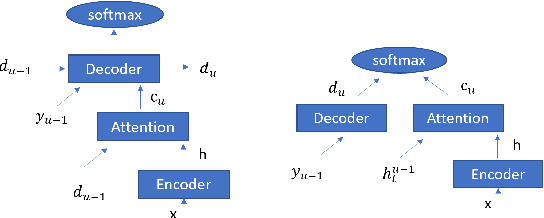
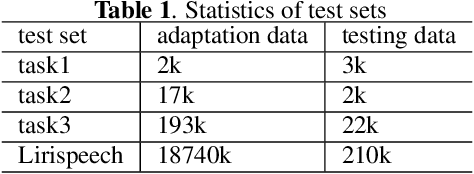
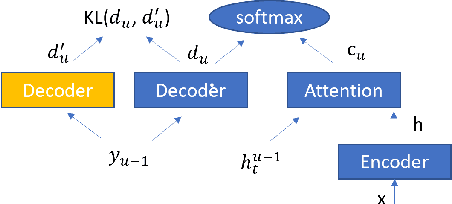
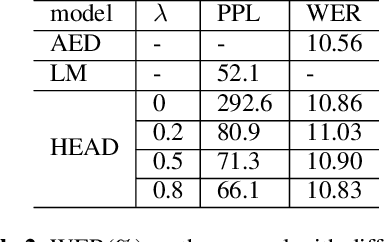
Abstract:Attention-based encoder-decoder (AED) speech recognition model has been widely successful in recent years. However, the joint optimization of acoustic model and language model in end-to-end manner has created challenges for text adaptation. In particular, effectively, quickly and inexpensively adapting text has become a primary concern for deploying AED systems in industry. To address this issue, we propose a novel model, the hybrid attention-based encoder-decoder (HAED) speech recognition model that preserves the modularity of conventional hybrid automatic speech recognition systems. Our HAED model separates the acoustic and language models, allowing for the use of conventional text-based language model adaptation techniques. We demonstrate that the proposed HAED model yields 21\% Word Error Rate (WER) improvements in relative when out-of-domain text data is used for language model adaptation, and with only a minor degradation in WER on a general test set compared with conventional AED model.
 Add to Chrome
Add to Chrome Add to Firefox
Add to Firefox Add to Edge
Add to Edge